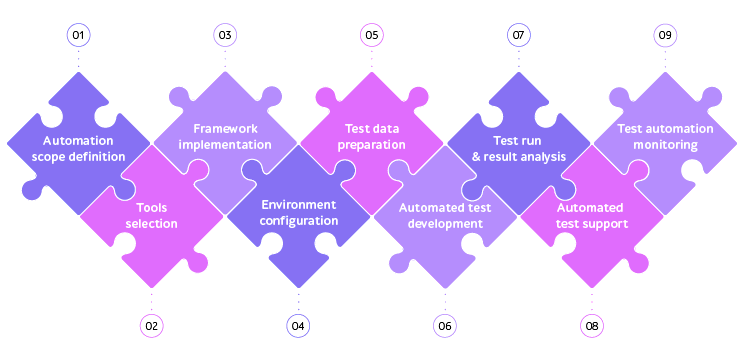
Test automation process overview
Today, software testing is an integral part of the development process. To reduce the time spent on testing, many companies opt for test automation. However, automation capabilities move beyond speed increase and include test coverage enhancement and overall QA costs optimization in the long run.
Moreover, test automation is a well-tailored process with defined stages. In this article, we will talk about the importance of this service and will highlight the steps to apply it correctly.
- Determine the scope
Any process starts with the definition. Therefore, before implementing test automation, you should determine the automation scope. When starting tests development, a QA engineer should first define the order according to the tests’ priority rate.
- Prepare to automate
Having quite profound experience in test automation, I can say the following: automated tests should cover the most stable part of the functionality and the one that is tested for about 3-4 times per week.
As a rule, smoke tests (or other regression tests) are chosen for that very purpose.
- Select tools for automation
As soon as the scope is defined, a QA engineer should select test automation tools. The tested interfaces define the package of applied tools. Different types of interfaces presuppose different tools’ range.
There is no any one-size-fits-all solution. The choice of a test automation tool will depend on the technology the software is built on. For example, QTP does not support Informatica. That means the tool cannot be used for the software. We prefer the most reliable and proven solutions: Selenium WebDriver, Coded UI, Ranorex, TestStack.White, Appium, Xamarin, and many more.
Having decided upon the tools, testers get to framework implementation.
- Develop the framework
The framework is the basis for further automated tests’ development. It provides an opportunity to optimize test development efforts by re-using the code. You can utilize any of the ready-to-use frameworks presented on the market, like the Robot framework for Selenium.
The usefulness of frameworks is hard to underestimate. Thanks to frameworks, it’s possible to maintain consistency of testing and improve re-usability. You can also count on minimizing code usage and improving the structure of tests, which is a perfect scenario for long-term projects.
- Configure the environment
All the tests run in the environment, which is to be well-configured. Upon this step, you should create and support the environment to successfully run automated tests and store the results.
Test automation will require test data, which means you are to prepare the set of files and test accounts beforehand. Otherwise, you tackle risks that may damage the process and provide you with irrelevant test results.

- Start to automate
Eventually, when all the preliminary preparations are done, testers can get down to automated test development. A regular process of providing new automated tests includes the following points:
- Selection of the manual test case according to the stated priorities
- Code writing for the automated test
- Adding the automated test to the debug test execution
- Adding the automated test to the test execution for newly created builds.
As well as analysis, the tests need support, which presupposes the process of updating automated tests along with the updates of the interface and/or business logic.
When the tests are launched, they should be monitored. You cannot let them go along without tracking the process. While monitoring the automated test, remember to take into consideration the following aspects:
- Automated test coverage, cost per test
- Useful vs. irrelevant results after test execution
- Cost per test
- The scope of support in comparison with the number of executed tests
- Economic effect (ROI, return on investment).
Tracking the process, keep in mind, that test automation is much more than computers launching test programs. It is also delivering information about quality.
Ultimately, mastering automation can significantly increase your business value. Automation includes many factors that need to be understood and addressed before the start of the process. Follow the main points to avoid the risks and get your benefits.
Alternatively, you can entrust this process to experts in the field of automation. Contact us to get advice on integrating automation into the testing processes of your software product.









